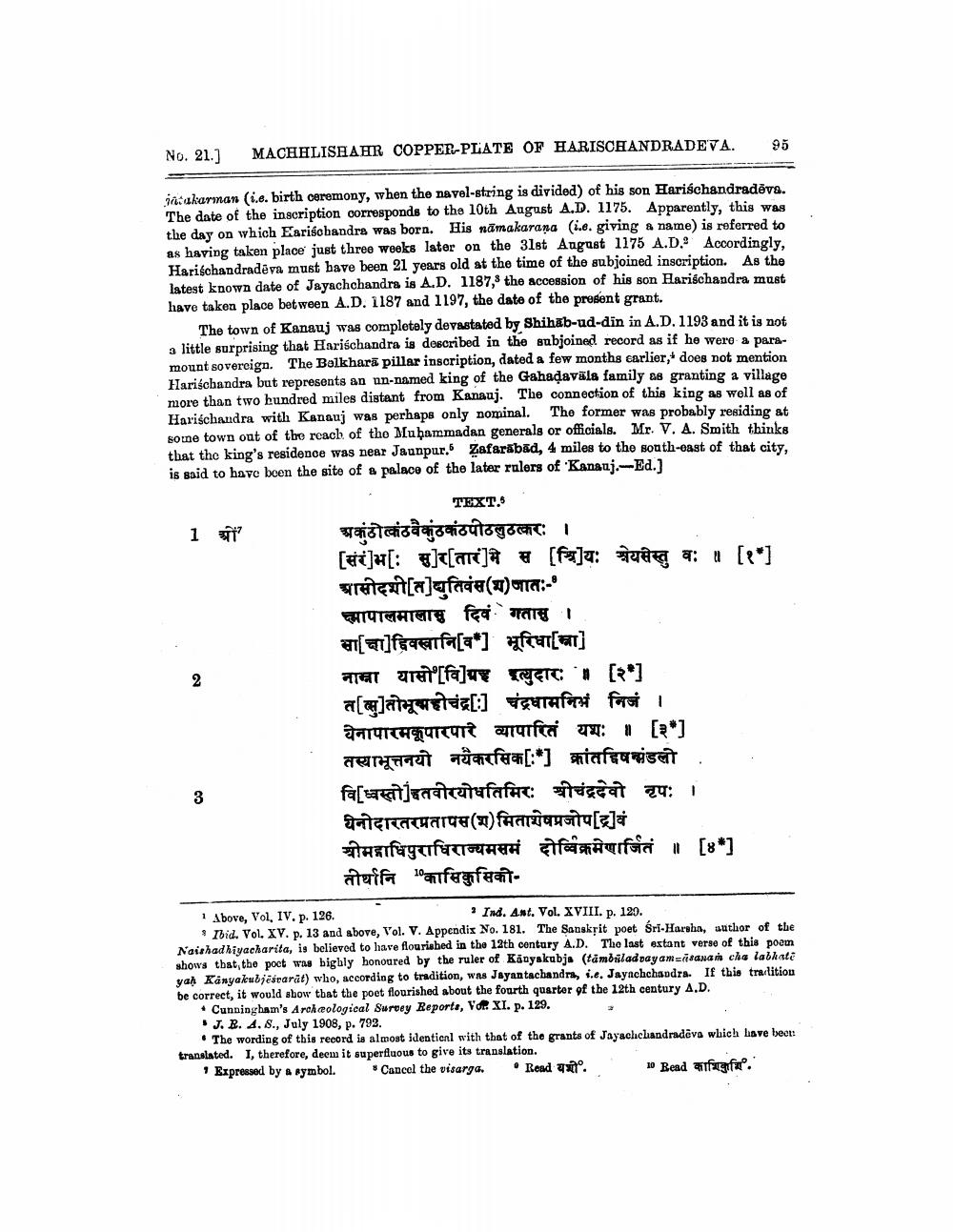________________
No. 21.]
MACHHLISHAHR COPPER-PLATE OF HARISCHANDRADEVA.
jatakarman (i.e. birth ceremony, when the navel-string is divided) of his son Harischandradeva. The date of the inscription corresponds to the 10th August A.D. 1175. Apparently, this was the day on which Earischandra was born. His namakarana (i.e. giving a name) is referred to as having taken place just three weeks later on the 31st August 1175 A.D. Accordingly, Harischandradeva must have been 21 years old at the time of the subjoined inscription. As the latest known date of Jayachchandra is A.D. 1187,3 the accession of his son Harischandra must have taken place between A.D. 1187 and 1197, the date of the present grant.
The town of Kanauj was completely devastated by Shihab-ud-din in A.D. 1193 and it is not a little surprising that Harischandra is described in the subjoined record as if he were a paramount sovereign. The Belkhara pillar inscription, dated a few months earlier, does not mention Harischandra but represents an un-named king of the Gahaḍaväla family as granting a village more than two hundred miles distant from Kanauj. The connection of this king as well as of The former was probably residing at Harischandra with Kanauj was perhaps only nominal. some town out of the reach of the Muḥammadan generals or officials. Mr. V. A. Smith thinks that the king's residence was near Jaunpur.5 Zafarabad, 4 miles to the south-east of that city, is said to have been the site of a palace of the later rulers of 'Kanauj.-Ed.]
1 श्र
2
3
95
TEXT.5
कुंडी कंठवे कुंडकंठपीठठत्करः ।
[संरं]भ[: सु]र[तारं ] मे स [वि]यः श्रेयसेस्तु वः ॥ [ १* ] wrétexit(x)qfier(x) Gra:-"
आपालमाला दिवं गतासु ।
भूरिधा [ना]
[r] द्विवस्वान [a*] नावा यासो' [वि] ग्रह बुदार। [२] त[]तोभूमीचंद्र [:] चंद्रधामनर्भ निजं । येनापारमकुपारपार व्यापारितं यमः ॥ [३] तस्याभूत्तनयो नयैकरसिक [: *] क्रांतद्दिषमंडली वि[ध्वस्तो]चतवीरयोधतिमिरः श्रीचंद्रदेवो नृपः । येनोदारतरप्रतापस (घ) मिताशेषमजोप [द्र]वं श्रीमद्गाधिपुराधिराज्यमसमं दोर्व्विक्रमेणार्जितं ॥ [ ४* ] तीर्थानि " कासिकुसिको
1 Above, Vol, IV. p. 126.
2 Ind. Ant. Vol. XVIII. p. 129.
Ibid. Vol. XV. p. 13 and above, Vol. V. Appendix No. 181. The Sanskrit poet śri-Harsha, author of the Naishadhiyacharita, is believed to have flourished in the 12th century A.D. The last extant verse of this poem shows that, the poet was highly honoured by the ruler of Kanyakubja (tambuladvayam-sanam cha labhate yah Kanyakubjesvarät) who, according to tradition, was Jayantachandra, i.e. Jayachchandra. If this tradition be correct, it would show that the poet flourished about the fourth quarter of the 12th century A.D.
Cunningham's Archaeological Survey Reports, Vol. XI. p. 129.
J. B. 4. S., July 1908, p. 792.
The wording of this record is almost identical with that of the grants of Jayachchandradeva which have been translated. I, therefore, deem it superfluous to give its translation.
Expressed by a symbol.
*Cancel the visarga.
• Read यशो
10 Bead fagfa.




